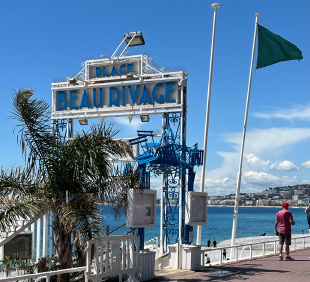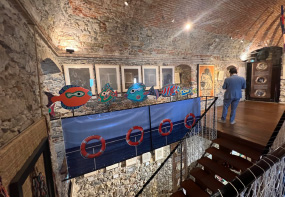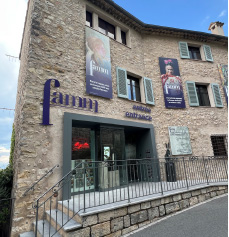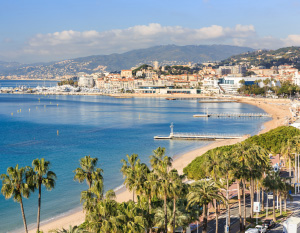IN AND AROUND NICE
From the airplane, the view of snow-topped mountains, craggy cliffsides, pool-strewn landscapes and megayachts in the glistening Mediterranean has produced goose bumps—what the French call Chair de Poule or chicken skin—and lured me to return since my first descent into Nice-Côte d’Azur airport in July 1990. After my recent three-week rental in Cannes, in April and May 2025, I devoted four days in Nice, a veritable open-air museum with an architectural heritage that dates to Roman times and features Italian Baroque and Art Deco as well as modern architecture.


Historically, it was annexed to France in 1860; later in the century, its mild winters lured northern Europeans and since 2021, Nice has appeared on UNESCO’s World Heritage List. The Promenade des Anglais, a wide avenue lined with Belle Epoque villas, offers a beautiful, wide pedestrian promenade adjacent to the beach. Place Massena, the city’s main plaza, is built atop the river which once divided old from new Nice; now, it’s directly connected with Nice-Cote d’Azur Airport via a low-cost public tram. Anantara Plaza Nice Hotel, located amidst designer shops facing the verdant square, offers a superb subterranean spa and SEEN by Olivier, a roof-top restaurant that views the park, the adjacent rose-colored buildings and the sea.
Hotel Nice Beau Rivage, where Matisse lodged in the early 20th century, features an expansive Beach Plage Restaurant on the sand and is even closer to the ever-active flower and produce market in Cours Saleya in Vieux Nice. My priority was to return to the Matisse Museum to see the largest collection of his artwork and to view the magical art at the nearby Marc Chagall Museum. Nice is the major destination for flights to the French Riviera (via Delta or La Compagnie) and a major Mediterranean cruise port and the ideal hub for rental cars, trains, or tours to the many alluring coastal resorts, perched villages and to Monaco.

MENTON
Menton, a typical coastal village with three marinas and a seafront bordered by low-rise pastel buildings with red tile roofs, sits at the southeast edge of France bordering Italy, less than an hour from Nice by train or car. It is best known for its micro-climate, lemon production, famous tropical gardens and beaches. What’s unique is its outdoor staircase that reaches the medieval Old City on an upper level with its Basilique Saint-Michel, a 17th century structure with an 18th-century bell tower.
Active visitors paraglide, sail, fish and hike to Italy, but my heart was set on seeing the mural painted on the walls of the wedding chapel in Menton’s Town Hall by artist, poet, author, playwright, and filmmaker, Jean Cocteau. I lunched on traditional fish broth, served with croutons and rouille, on the tree shaded patio at Le Petit Port just opposite the historic fort that houses The Bastion, which displays some Jean Cocteau artwork from the Séverin Wunderman collection. And, though I missed dining on one of the terraces at three-star chef Mauro Colagreco’s Mirazur, I lunched at La Terrasse by Albane, his pop-up restaurant at the JW Marriott rooftop in Cannes.

MOUGINS
Mougins is a medieval hilltop gem with a bevy of art galleries, boutiques, cafes and fine restaurants along ancient, narrow streets leading to the 11th century Saint-Jacques-le-Majeur. Picasso lived his last dozen years in the village and a large sculpture of the artist’s head welcomes visitors to the plaza near the tourist office and the Lavoir, the washhouse where women gathered to do their laundry from 1894 to 1970. I first visited the perched village for a solo dinner at Le Moulin de Mougins, within the 16th century olive mill (moulin) then operated by three-star Michelin chef Roger Vergé (1930-2015), known for his truffle-stuffed zucchini blossoms. I returned to the Lavoir in 2023, on the 50th anniversary of Picasso’s death, for a photography exhibit that honored him, and again this year to see original regional artwork, there. The brand-new Femmes Artistes Musee Mougins (FAMM) displays part of Christian Levett’s collection of more than 500 pieces by female artists.
Well-known Americans—Mary Cassatt, Elaine de Kooning, Helen Frankenthaler, Lee Krasner and Louise Nevelson are represented—as well as Dora Maar, Francoise Gilot, Berthe Morrisot and Blanche Hoschedé-Monet, who regularly painted alongside Claude Monet, her stepfather and father-in-law. We lunched at L’Amandier, a multi-storied restaurant founded by Roger Vergé, where the food and service were impeccable and the myriad photos of Vergé and Picasso are as amazing as the expansive views.

CANNES
Cannes is smaller than Nice, pristine and perfect, and ideally walkable. From the posh new marina along the curve of La Croisette, the tree-lined seafront boulevard, visitors pass the five-star hotels (The Carlton, The Martinez, The J.W. Marriott, The Mondrian and The Majestic Barrière) and the red-carpeted stairs at the Palais des Festivals, and reach the old port across from the Hotel de Ville, where there’s a Carousel, a pétanque court (aka “boules” a bocci-like game) and a weekend brocante (flea market). It’s next to the Old City, where former fishermen’s homes house teeny, but tony, little restaurants—my favorite is Le Maschou—on a steep hill called Le Suquet, which leads to the daily Forville market. After decades of travel to hotels on the Riviera, in 2018, I started renting apartments in Cannes as a home base, because I can walk to the morning market, the marina, the old town, posh hotels or a variety of shops (Armani to Zara) and restaurants (Bobo to Vesuvio) and take a train or UBER to other regional destinations.
The French Riviera is my happy place; it could become yours.
Contributor Irvina Lew’s new book Forays in France: A Flavorful Memoir (foraysinfrance.com)
features vignettes from Paris, The Riviera, and Wine Regions.






